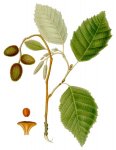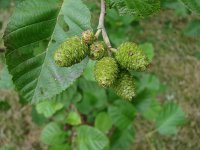Alder gray
Alnus incana (L.) Moench.
Botanical characteristics. Family birch. A tree up to 20 m high with a shiny, smooth, gray bark. Leaves alternate, petiolate, pubescent, serrate, ovate or broadly elliptical, arranged in three rows. Blooms in April before the leaves bloom. Flowers are same-sex, collected in inflorescences-earrings. Cones with seeds remain on the branches until March, in spring seeds from cones fall asleep.
Spread. It grows in damp places: in swamps, in valleys of rivers, along the shores of closed reservoirs. Distributed in the forest and forest-steppe zones of the European part of the country, the Urals and Western Siberia.
Used parts of the plant.
Cones (orotonia) and the bark of alder, occasionally - leaves.
In the aplicots of alder, there are many tannins (including 2.5% tannin and 3.7% gallic acid); In the leaves - flavonoids, acids (coffee, chlorogenic and protocatechin), 205 mg% ascorbic acid. Alder crust also contains tannins and triterpinoids.
Application.
It is based on the pronounced astringent and anti-inflammatory effect of alder. Assign with acute and chronic gastritis and enterocolitis, accompanied by diarrhea, with dysbacteriosis and dysentery. Aplicata alder is a good hemostatic.
Fresh alder leaves are sometimes used for colds as external.
Alder helps to save the garden and vegetable garden from the bear, which, as is known, is very difficult to fight. Medvedka does not tolerate the smell of fresh alder. In order for the bear to leave the garden, branches of alder are planted around it.
Preparation. 2-3 tablespoons cones pour 0.5 liters of boiling water, boil over low heat for 20 minutes, add to the original volume. Take a decoction of 2 tablespoons 5-6 times a day on an empty stomach.





Comments
When commenting on, remember that the content and tone of your message can hurt the feelings of real people, show respect and tolerance to your interlocutors even if you do not share their opinion, your behavior in the conditions of freedom of expression and anonymity provided by the Internet, changes Not only virtual, but also the real world. All comments are hidden from the index, spam is controlled.